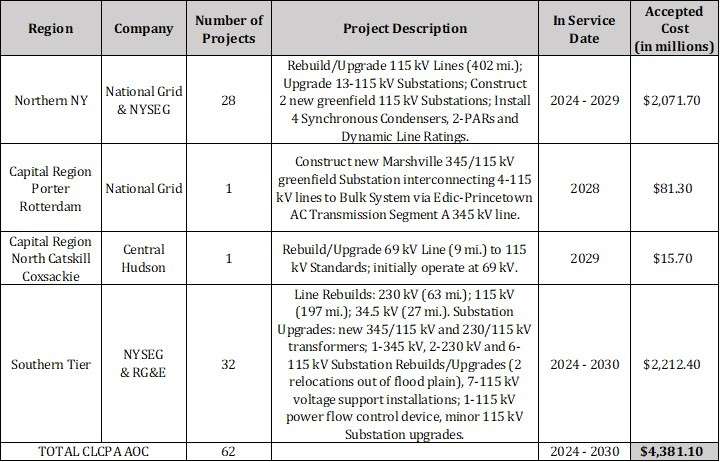Plugged In To Energy & Telecom
Coverage of Energy and Telecommunication News & Policy Across New York State
February 22, 2023
What’s Inside
- PSC Approves Transmission Investments
- Governor Announces Statewide Interoperable Communications Grant Awards
- NYPA Issues Report on Sustainable Land Practices Integrating Agriculture and Solar Systems
- Oneida County Executive Resigns from NYPA Board of Trustees
- Central Hudson Announces New CEO
- Legislative Update
- Regulatory Update
- In The News
PSC Approves Transmission Investments
At their regular meeting on Thursday, the PSC approved an order to implement transmission planning pursuant to the Accelerated Renewable Energy Growth and Community Benefit Act which requires the PSC and DPS to plan the electric transmission infrastructure necessary to meet the renewable energy targets established in the CLCPA.
Prior to the Act, transmission infrastructure investment decisions were primarily driven by utility service obligations related to the provision of safe and reliable service at just and reasonable rates to the specific utility’s customers.
The upgrades target “areas of concern” where many new renewables are expected to come online and where existing renewable generation is already experiencing curtailments. In combination, these factors would exceed the capability of the local transmission system. The PSC accepted cost estimates of just under $4.4 billion that are subject to a 50%/-25% variance, meaning the final cost could be as high as $6.6 billion.
Proposed Areas of Concern Projects
The projects are subject to additional scrutiny through siting approvals by the commission and will also go to the Federal Energy Regulatory Commission for cost recovery approval because the costs are spread across all ratepayers, instead of being confined to the ratepayers within the site’s service area. The projects are granted a wide latitude on cost, with cost estimates that are subject to a 50%/-25% variance.
Estimated Annual Dollar Impact for Typical Customers
Commissioner Burman wrote in dissent stating that “[w]e are creating an unsustainable system where consumers and ratepayers assume greater and greater risks going forward with minimal guarantees. Moreover, we aren’t even setting up a realistic process that is ensuring the timing of all this is possible.”
Commissioner Howard also dissented saying “[i]f we believe that these large capital expenses are absolutely necessary as a part of state policy, then the state Legislature needs to help pay for them, not us. Because the members of this body become the de facto tax raisers to implement public policy.” Commissioner Howard also took issue with the allowable cost variance providing too much leeway.
Governor Announces Statewide Interoperable Communications Grant Awards
The Governor announced more than $62 million has been awarded to 14 counties through the Statewide Interoperable Communications Grant (SIGC) targeted program to strengthen emergency communications and interoperability infrastructure used by local first responders. SCIG, administered by the Division of Homeland Security and Emergency Services, provides funding to enhance public safety through improving and modernizing infrastructure, addressing communications deficiencies, implementing national interoperability channels, and boosting regional connectivity between counties and systems.
The program reimburses county expenditures for the following purposes:
- Maintenance and sustainment expenditures for LMR systems;
- Technological updates and refresh of existing LMR systems, including equipment and software;
- Build-out of new larger-scale systems and infrastructure, expanding access to radio channels and equipment for local and state agencies within a region; and solutions which may aid in resolution of interoperability channel conflicts along the Canadian border;
- Expansion of communications consortiums to currently non-participating counties and finalization of agreements between new and current consortium members. (These agreements, along with the full integration of SOPs, serve as the basis for efficient utilization of frequency resources, infrastructure and technology, as well as operational, administrative, and governance functions between counties, State Police, and other State agencies);
- Subsequent phases of communications-related projects previously initiated; including awards to counties pursuing additional build-out of their systems where coverage and frequencies are lacking. (This will help fulfill the “network of networks” vision by completing connectivity between regions); and
- Implementation of technologies to further NG911 development in accordance with the State plan and vision (i.e., SCIP).
Governor Hochul said:
NYPA Issues Report on Sustainable Land Practices Integrating Agriculture and Solar Systems
The New York Power Authority (NYPA) announced the release of a new report, Agrivoltaic Leading Practices, that recommends proven and innovative approaches on integrating dual-land use for agriculture and solar energy production.
In March 2022, NYPA announced receipt of a $102,000 grant to fund the report through the American Public Power Association’s (APPA) Demonstration of Energy & Efficiency Developments (DEED) program. The program funds research, pilot projects and education to improve the operations and services of public power utilities. NYPA collaborated with EPRI, an independent, non-profit energy research and development organization, to conduct research and publish the report.
Researchers who authored the new report examined how native vegetation, pollinators, low maintenance plants, agricultural crops as well as grazing livestock can coexist on the same parcel of land as a solar energy project.
The study determined that leading agrivoltaic practices are those that promote the following:
- Collaboration between the farmer, solar developer, and the power purchaser early in the site selection process to mitigate concerns and establish protocols for the development and management of the solar site that work for the farmer’s needs.
- Educational programming that fosters a two-way dialogue between farmers and solar developers to create a mutually beneficial site.
- State-level incentive policies for co-location that makes site-selection more affordable for developers.
- The development of solar site safety practices that compliment a partnering farmer’s crop rotation schedule to ensure that they can access the site to tend to their crops or herd.
- Continued research to identify site-specific crops and array design alterations to accommodate the selected crop where appropriate.
New York State Agriculture Commissioner Richard A. Ball said:
Oneida County Executive Resigns from NYPA Board of Trustees
Oneida County Executive Anthony Picente resigned as member of the NYPA Boards of Trustees this week citing differences in opinion with the direction of the state. Picente has served on the board since 2015. Picente’s resignation letter stated that he could no longer in good conscience serve an administration that he believes is damaging the “very foundation of our economy, public safety and health of the entire state.” He also said he disagreed with the Governor’s proposal to allow NYPA to build renewable generation projects believing that the State should not be competing with the private sector.
Central Hudson Announces New CEO
Central Hudson’s board has replaced the utility’s CEO as the company tries to address a botched rollout of a new billing system. The board announced Christopher Capone, the chief financial officer, as CEO on Monday. He replaces Charles Freni, who has led the utility since 2018.
Capone has worked at Central Hudson since 2003 and was most recently an executive vice president. He was also previously the company’s chief financial officer before his planned retirement was announced in June 2022. Capone’s appointment is effective immediately. Freni will stay on at the company to assist with the transition before he retires.
Capone said in a statement:
Legislative Update
State Assembly Agendas (Bills of Interest)
_________________________________________________________________
N/A – No Session
_________________________________________________________________
State Senate Agendas (Bills of Interest)
N/A – No Session
________________________________________________________________
Bills Passed Last Week
Passed Assembly Only:
N/A
Passed Senate Only:
S.2510-A Ramos/No Same As – Requires applicants for major projects located near an environmental justice community to submit an enhanced public participation plan.
S.3328 Fernandez/No Same As – Directs the department of environmental conservation to promulgate air quality standards for emissions of certain toxic air contaminants.
S.4134 Parker/A.279 Carroll – Implements the “New York State Build Public Renewables Act”
Passed Both:
A.978 Paulin/S.2227 Parker – Requires gas corporations to file annual gas safety reports. Chapter Amendment
A.1285 Fahy/S.1320 Breslin – Enacts the digital fair repair act. Chapter Amendment
A.1286 Pretlow/S.1317 Stewart-Cousins – Relates to disproportionate impacts of environmental facility siting on disadvantaged communities. Chapter Amendment
A.2896 Alvarez/S.1345 Parker – Relates to critical energy infrastructure security and responsibility and provides for the protection of critical infrastructure in the state. Chapter Amendment
S.1338 Comrie/A.603 Braunstein – Requires notice to members of the legislature and certain local officials relating to certain construction and other projects affecting such members’ and officials’ districts. Chapter Amendment
State Register
Public Service Commission
- Transfer of Street Lighting Facilities (Proposed)
- Notice of Intent to Submeter Electricity (Proposed)
In The News
How New York Will Implement the $4.2 Billion Environmental Bond Act Passed by Voters in 2022?
Support grows for ‘climate negligence‘ measure in New York.
Central Hudson ousts CEO Charles Freni after billing disaster.
Lockport Journal: Misinformation is filling New York’s climate plan information void.
EPA climate fund may not be a green bank after all.
New York’s new constitutional right to a clean environment faces first judicial test.
Building Decarbonization Central to New York State’s Climate Plan.
Advocates propose expanding NY bottle bill.
NYPA and NYSERDA announce new battery energy storage technology that demonstrates peak shaving, cost-saving benefits at New York Power Authority.



